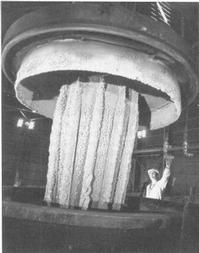


Chapter 10
I 1. Introduction
II 2. The Role Of Technology
III 3. Some Highlights Of Australian Minerals Technology
i Gold
ii Copper
iii Lead-zinc-silver
iv Technology in iron ore mining
v Iron and steel technology
vi Nickel
vii Mineral sands
viii Bauxite, alumina, aluminium
IV 4. Other Technological Achievements (in brief)
V 5. Export Of Technology
VI 6. Education And Research
VII 7. The Scientific Societies
VIII 8. Conclusion
References
Index
Search
Help
Contact us

The innovative approach which has been such a strong feature of the development of mining and concentrating practices at Broken Hill is also strongly in evidence in the extractive metallurgy industries stemming from that source, including those located at Port Pirie, Risdon and Cockle Creek. The Port Pirie plant remains the largest single lead smelter in the world with an output up to 230,000 t/yr of refined lead; it also produces some 40,000 t/yr of electrolytic zinc from accumulated and current blast furnace slags. The Risdon plant with recent extensions will be the world's largest single zinc producer at 320,000 t/yr of electrolytic zinc, partly derived from Broken Hill concentrates but including also concentrates from the Read-Rosebery mines and a variety of other sources. The Cockle Creek industries have a capacity of 40,000 t/yr of Prime Western grade zinc, 30,000 t/yr of refined zinc, and 30,000 t/yr of lead bullion, also 140,000 t/yr of sulphuric acid; initially the plant was set up to treat lead and zinc concentrates from Broken Hill but a range of materials from other sources has been included to take advantage of the metallurgical capacity of the Imperial Smelting Process for simultaneous smelting of zinc and lead in a single blast furnace. The Cockle Creek Imperial Smelting Furnace was the world's first installation in 1961.
Port Pirie technology
Port Pirie's greatest claim to distinction is the continuous refining practice with which the name of George Kenneth Williams is indissolubly associated. As a young graduate in mining engineering from the University of Melbourne, Williams commenced in 1921 a wide-ranging programme of modifications to the smelting and refining practices, commencing with the desilverizing which resulted in the transformation of an inefficient, hot and unhygienic batch operation carried out manually in several large pots into a single stream automatic operation in one large vessel. The group led by Williams and supported with a rare and enlightened degree of management co-operation then progressively changed all the other batch refining operations to single stream continuous processes. This was substantially completed by 1935 and the team then directed their attention to other improvements in lead smelting technology, sintering and blast furnace design and operation, culminating in the development of a single blast furnace to handle the entire throughput, associated with updraft sintering and recovery of sulphuric acid, vacuum dezincing of the desilverized lead, and many simplifications and cost saving practices. These developments, which were in many respects the outcome of plant scale research (involving delicate balances between the research team requirements and the regular plant production operations) resulted in undisputed leadership in lead metallurgy throughout the world for many years. A vitally important part of the programme was played by the laboratory analytical and research group which was distinguished for the application and further development of a wide range of analytical techniques, including atomic absorption spectrometry and kindred instrumentation which made possible the determination and recording of major constituents and minor impurities in a matter of minutes whereas traditional methods involved hours or days.

People in Bright Sparcs - Williams, George Kenneth
 |
Australian Academy of Technological Sciences and Engineering |  |
© 1988 Print Edition page 748, Online Edition 2000
Published by Australian Science and Technology Heritage Centre, using the Web Academic Resource Publisher
http://www.austehc.unimelb.edu.au/tia/714.html